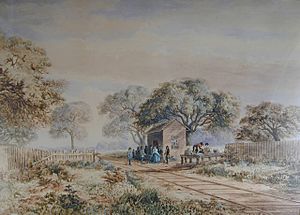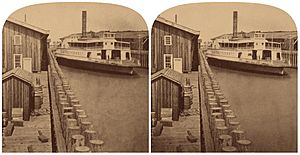San Francisco and Oakland Railroad facts for kids
| Overview | |
|---|---|
| Locale | Northern California |
| Dates of operation | 1862–1870 |
| Successor | Central Pacific Railroad |
| Technical | |
| Track gauge | 4 ft 8 1⁄2 in (1,435 mm) standard gauge |
The San Francisco and Oakland Railroad (SF&O) was a railway built in 1862. It offered a special ferry-train service. People would take a ferry from San Francisco and then switch to a train in Oakland. The train then traveled to San Antonio.
In 1868, the Central Pacific Railroad decided that Oakland would be the very end of the First transcontinental railroad on the West Coast. So, they bought the SF&O. Starting November 8, 1869, a part of the SF&O line became the westernmost section of the transcontinental railroad. Later, it became part of the Southern Pacific Railroad. The tracks in Oakland were updated with electricity in 1911. They were even extended across the San Francisco–Oakland Bay Bridge in 1939. However, the train service stopped in 1941.
Contents
A Railroad Story: The San Francisco and Oakland Line
The San Francisco and Oakland Railroad (and Ferry Co.) started in October 1861. Local people in Oakland, led by Rodman Gibbons, created it. Their goal was to make it easier to travel to Oakland. They planned to use a ferry from San Francisco to a small dock at Oakland Point. From there, passengers could ride a train into Oakland.
Train service began in September 1862. The trains ran along 7th Street to a station in downtown Oakland at Broadway.
Expanding the Train Tracks
More and more people started using the service. Because of this, the company planned to make the line longer. In 1864, the tracks were extended. They went over a bridge across Indian Creek Slough, which is where Lake Merritt drains. Then, the tracks followed a path next to San Antonio Creek (also known as the Oakland Estuary). The line ended at the Commerce Street Wharf in San Antonio.
Building this extension and a new, bigger ferry cost a lot of money. Because of these costs, Rodman Gibbons and his partners lost control of the SF&O company in 1865. A. A. Cohen, who was the president of the San Francisco and Alameda Railroad, took over.
The Transcontinental Railroad Connection
In April 1868, the Central Pacific Railroad (CP) decided that Oakland would be the final stop for the transcontinental railroad on the West Coast. A company owned by CP then bought most of the SF&O stock from A. A. Cohen in August 1868. The SF&O was struggling at the time. CP began to make the small dock at Oakland Point much bigger.
In August 1869, the CP company also bought most of the stock of the SF&A. This railroad had gone bankrupt after the 1868 Hayward earthquake. In 1870, CP combined the two local railroads, SF&O and SF&A. Then, they brought them fully into the Central Pacific system.
Connecting the West
Meanwhile, the Western Pacific Railroad (1862–1870) had planned a route from San Jose through Niles Canyon and Altamont Pass to Sacramento. But they ran out of money in 1866. They had only laid 20 miles of track from San Jose into Niles Canyon.
By 1868, a CP company bought the Western Pacific line. They restarted construction in February 1868, working south from Sacramento. They aimed to connect with the line that started in Niles Canyon in June 1869. Also in June 1869, they added a new line from Niles northwest towards Oakland. In September 1869, this new line was temporarily connected to the SF&A at San Leandro.
The very first Western Pacific train from Sacramento arrived on September 6, 1869. It reached the SF&A Alameda Terminal. From there, passengers took an SF&A ferry to San Francisco. This happened just in time for the 1869 State Fair in Sacramento. It marked the completion of the first transcontinental railroad to the Pacific Ocean!
Oakland's Big Day
Two months later, the connection to the SF&O was finished. The small Oakland Point dock was made even larger. On the morning of November 8, 1869, the first transcontinental train used the new, bigger ferry terminal at Oakland Point. It traveled on the SF&O line and the Western Pacific Railroad to get to Sacramento and then continued east on the Central Pacific Railroad. The city of Oakland held a huge party later that day to welcome the first transcontinental train arriving from the east.
Changing Train Routes
Having many long-distance passenger and freight trains use 7th Street, a main street in Oakland, was not ideal. It was difficult for both the city and the railroad. So, during 1869 and 1870, a bypass track was built. It started in San Antonio and used a new bridge across Indian Creek Slough. This new track led to 1st Street and then along 1st Street to Oakland Point. At first, only freight trains used this bypass. But later, long-distance passenger trains used it too. A new station for them was built at 1st Street and Broadway, which is now Jack London Square.
After 1879, the transcontinental trains stopped using the Altamont Pass Niles Canyon route. They took a shorter way from Sacramento through Benicia to reach Oakland Pier. However, trains going to Los Angeles continued to use the old SF&O and Western Pacific routes to reach San Jose.
Electrification and End of Service
On 7th Street, there was still a lot of local steam train traffic. The service was extended further into East Oakland. The Central Pacific Railroad was leased to the Southern Pacific Railroad in 1885. In 1911, Southern Pacific began to add electricity to its local train service in the East Bay (San Francisco Bay Area). The Oakland 7th Street line was extended to Dutton Avenue in San Leandro. It carried more passengers than any other line in the system.
In 1939, a company called Interurban Electric Railway (IER), which was part of Southern Pacific, rerouted the line. It now went over the San Francisco-Oakland Bay Bridge into the San Francisco Transbay Terminal. IER service on the 7th Street line stopped in March 1941. But the track on 7th Street from Broadway to Pine Street was used again from 1943 to 1946 during World War II. This allowed Key System streetcars to reach several military bases.
Ferryboats: Connecting the Bay
The first ferryboat used by the SF&O was called the Contra Costa. It was rented and had previously traveled from San Francisco to Broadway. The rental ended in 1864. The SF&O then bought a ferryboat named the Louise to take its place.
As the railroad line got longer, more and more people used the service. The Louise soon became too small for regular use. So, a larger riverboat called the Washoe was bought. It had been damaged in an explosion. It was rebuilt to be a ferryboat and put into service. In 1868, the Central Pacific Railroad took control of the SF&O. They expected a lot more passengers when the transcontinental railroad was finished in Oakland. So, they ordered a brand new, even bigger ferryboat. It was built at a new shipyard at Oakland Point and named the El Capitan.
Locomotives: The Engines of the Railroad
The SF&O first bought a small, unnamed 2-2-0 type locomotive. They also bought a larger 4-4-4 type tank locomotive called the Liberty. In 1863, the SF&O needed another engine. They bought a 2-2-4 type locomotive and express car from a line in San Francisco. It didn't have a name, but people unofficially called it Old Betsy.
By 1869, a more powerful engine was needed to pull longer trains. So, a new 4-4-0 type locomotive was ordered and named the Oakland. When the SF&O joined the Central Pacific Railroad in 1870, the old SF&O locomotives were sent to other places on the CP system. Central Pacific engines were then brought in to pull the local trains on 7th Street.
| Name | Builder | Type | Date | Notes |
|---|---|---|---|---|
| Vulcan Iron Works, San Francisco | 2-2-0 | 1862 | ||
| Liberty | Vulcan Iron Works, San Francisco | 4-4-4 Tank locomotive | 1862 | became California Pacific RR # 178; rebuilt as 4-4-0 in 1872; became Stockton & Copperopolis # 3; then Southern Pacific # 1101; retired 1892 |
| Old Betsy | 2-2-4 | purchased 1863 from Market Street Railroad of San Francisco | ||
| Oakland | Cooke Locomotive and Machine Works | 4-4-0 | 1869 | became California Pacific RR shop switcher in Sacramento; retired 1877 |



